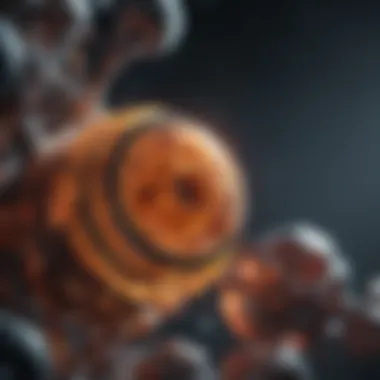The Significance of CCDB Survival Cells in Research


Intro
The exploration of CCDB survival cells is not just a niche subject but rather an essential piece of the puzzle that plays a pivotal role in modern research. With advances in biological and medical sciences pushing boundaries, the understanding of these cells can lead to breakthroughs that seem almost like science fiction. Essentially, CCDB survival cells are cells designed to endure extreme conditions that would typically spell doom for other life forms. This examination seeks to dissect their properties, mechanisms, and the far-reaching implications they have across various fields.
By unpacking the critical functions and applications associated with CCDB survival cells, we aim to shine a light on their relevance in contemporary scientific inquiry. Given their adaptability and resilience, understanding these cells can help researchers confront challenging questions about life, survival, and the potential for harnessing such properties in applications ranging from medicine to environmental science.
As we venture further, our focus will be on both the foundational concepts surrounding CCDB survival cells and future research directions that promise to offer deeper insights into their functionalities. This narrative will set the stage for researchers, educators, and professionals to engage with a topic that has significant consequences for how we perceive resilience in biological entities.
Key Concepts
Definition of Primary Terms
Let’s start with a solid definition.
- CCDB Survival Cells: Specialized cells known for their remarkable ability to survive under harsh environmental conditions. These conditions could include extreme temperatures, varying pH levels, and even radiation.
These cells are often observed in extremophiles, organisms that thrive in environments that would be lethal to most life forms.
Related Concepts and Theories
A strong understanding of CCDB survival cells requires a grasp of several intertwined concepts:
- Extremophiles: These are organisms, including bacteria and archaea, that exist in extreme conditions, often informing our understanding of CCDB survival.
- Cellular Mechanisms: This encompasses the biological processes that enable survival, such as DNA repair mechanisms, antibiotic resistance, and metabolic adjustments.
- Biotechnological Applications: The integration of CCDB survival cells into practical use can enhance research methodologies, especially in synthetic biology and medical applications.
"The resilience of CCDB survival cells is not just a scientific curiosity; it holds the key to potential advances in various fields."
Future Directions
Gaps Identified in Current Research
Despite the excitement surrounding CCDB survival cells, several gaps in current research can often leave questions unanswered. Key areas include:
- Limited understanding of the specific mechanisms used by these cells to withstand extreme conditions.
- The need for advanced methods to study and manipulate these cells effectively.
- Insufficient exploration of how these cells interact with other biological systems, which could signify larger ecological roles.
Suggestions for Further Studies
To bridge existing gaps, several promising directions for future studies come to mind:
- Investigation of Genetic Adaptations: Understanding the genetic make-up that allows these cells to survive extreme environments could be a game changer.
- Longitudinal Studies: Long-term observation of these cells in varied conditions can reveal much about their adaptability and mechanisms.
- Interdisciplinary Approaches: Collaboration between biologists, ecologists, and medical researchers may yield comprehensive insights into CCDB survival cells and their potential applications.
By engaging with these suggestions, researchers can contribute significantly to the body of knowledge surrounding CCDB survival cells, ensuring that future studies paint a broader picture of their relevance in scientific discourse.
Prelims to CCDB Survival Cells
Understanding the function and significance of CCDB survival cells offers valuable insights into various scientific fields. These cells, noted for their resilience against unfavorable conditions, present a myriad of benefits. For researchers and professionals, grasping their mechanisms can lead to innovative breakthroughs in areas such as medicine, environmental science, and biotechnology.
The role of CCDB survival cells extends beyond the confines of traditional cell biology. They exhibit unique adaptive behaviors that challenge common perceptions about cellular limits. As we explore this topic, we aim to uncover layers of complexity that underline their importance in modern research methodologies. By analyzing their structural and functional attributes, readers will gain a deeper understanding of how these cells contribute to vital scientific advancements.
Definition and Overview
CCDB survival cells can be defined as specialized cellular entities that maintain their viability in harsh and detrimental environments. Their adaptability under extreme conditions—like drought, high salinity, or acidic environments—make them of great interest in scientific exploration.
Survival mechanisms vary widely and can include changes in metabolic processes, cellular structures, and gene expression patterns. For example, some survival cells might synthesize protective proteins or alter their membranes to minimize damage. In short, they are not mere bystanders in their habitats but active participants that navigate challenges adeptly.
Historical Context


The exploration of survival cells dates back several decades, but their significance gained traction in the late 20th century as advances in molecular biology began to elucidate cellular behavior under duress. Initially, researchers were focused primarily on the survival of cells in extreme temperatures, often in the context of extremophiles—organisms that thrive in environments considered inhospitable to most life forms.
However, this area has evolved tremendously. For instance, studies in the 1980s highlighted dehydration resistance in plant cells, paving the way for modern genetic studies on resilience. As we move into the 21st century, with tools like CRISPR and genome sequencing, the ability to manipulate and study these survival mechanisms has significantly expanded. With the characteristics of CCDB survival cells in the spotlight, interdisciplinary approaches have emerged, casting a broader understanding of their implications across fields such as agriculture, healthcare, and ecological conservation.
Biological Mechanisms of Survival Cells
Understanding the biological mechanisms of CCDB survival cells is crucial as it delves into how these cells navigate challenging environments. The intricacies of these mechanisms are fundamental in comprehending cell resilience and adaptability. In this section, we will unravel various adaptive strategies and metabolic pathways that survival cells employ to thrive, even when the odds are stacked against them.
Cellular Adaptation Strategies
CCDB survival cells showcase impressive cellular adaptation strategies. These strategies can be quite diverse, allowing for a variety of responses to adverse conditions. One of the noteworthy strategies includes forming protective structures. For instance, some cells form spores when exposed to harmful conditions, essentially entering a dormant state until better conditions arise. This ability to withstand extreme environmental stressors, such as heat or desiccation, illustrates a remarkable innate resilience.
Another strategy involves the modification of cellular functions. Cells can shift their metabolic pathways to utilize different energy sources under resource scarcity. This flexibility enables survival cells to adapt to changing environments while maintaining essential operations. In some instances, this adjustments lead to temporary physiological changes that help the organism keep its functions alive, which is quite a fascinating aspect of these cells.
Metabolic Pathways Involved
Metabolic pathways play a vital role in the functioning of survival cells, comprising various intricate processes that allow these cells to generate energy and sustain themselves. Understanding these pathways reveals how survival cells adapt biologically.
Anaerobic Metabolism
Anaerobic metabolism is a significant aspect of survival cells. This metabolic process occurs in the absence of oxygen, allowing cells to generate energy through alternative pathways. A key characteristic of anaerobic metabolism is that it can take place quickly, providing a rapid response to immediate energy demands when oxygen levels are low. This makes it a popular choice, especially in environments where oxygen is scarce or fluctuates significantly.
A unique feature of anaerobic metabolism is its reliance on fermentation or electron transport mechanisms, which avoids the need for oxygen entirely. One advantage of this pathway is the ability of cells to survive in anoxic conditions, making them extremely valuable for both research and practical applications. However, the downside includes lower energy yield compared to aerobic metabolism, which may limit long-term survival unless other adaptations are in play.
Fermentation Processes
Fermentation processes add another layer to the benefits provided by survival cells. Fermentation allows cells to convert carbohydrates into acids, gases, or alcohol, again in the absence of oxygen. This method is vital not only for energy production but also for the generation of metabolic byproducts which can be useful in various applications. A significant characteristic of fermentation is its efficiency; it enables cells to extract energy under conditions that would otherwise be lethal.
Fermentation processes also help in maintaining cellular homeostasis by recycling NADH back to NAD+, a cofactor essential for sustaining glycolysis. The unique feature of fermentation processes is that they can produce end products that are commercially valuable, such as ethanol and lactic acid. However, these end products can accumulate, which can ultimately be toxic to the cell if not regulated properly.
Genetic Regulation
Genetic regulation governs how survival cells modulate their responses to environmental challenges. This regulation entails complex networks that dictate gene expression and allow the cell to adapt efficiently and effectively.
Gene Expression Profiles
Gene expression profiles are a cornerstone of genetic regulation in survival cells. They reflect how genes are selectively activated or silenced in response to environmental stimuli. A key characteristic is that these profiles can change rapidly, allowing for immediate responses to shifting conditions.
These dynamic profiles allow researchers to identify which genes play crucial roles during stress responses, making it a beneficial focus for this article. The unique feature is that advances in methodologies, like RNA sequencing, enable scientists to paint a detailed picture of gene interactions during various survival scenarios. However, the complexity of these networks can complicate the interpretation of data, which presents challenges in drawing clear conclusions.
Epigenetic Factors
Epigenetic factors represent another layer of genetic regulation, influencing how and when genes are expressed without altering the underlying DNA sequence. This aspect is integral to the adaptability of survival cells. One of the remarkable characteristics is the role of epigenetic modifications—such as methylation and histone modification—in regulating gene activity during stress conditions.
The significance of epigenetic factors lies in their potential for reversible changes, offering cells a flexible mechanism to respond to environmental challenges. Researchers view it as an avenue of exploration, as understanding these processes can pave the way for new therapeutic developments. However, the variable response of epigenetic modifications may lead to unpredictable outcomes, complicating research efforts in the field.
Applications of CCDB Survival Cells
The examination of CCDB survival cells presents a remarkable intersection of biological science and practical application. Recognizing their potential throws light on innovative strategies and methodologies that can be explored across several disciplines. The key to unlock new pathways for research and application begins with understanding how these cells can be harnessed in varied settings, whether medical, environmental, or biotechnological.
In Medical Research
Cancer Treatment Strategies
In the realm of oncology, CCDB survival cells present a fascinating avenue for developing novel cancer treatment strategies. These cells possess an impressive resilience to harsh conditions, a trait that can be exploited to improve therapeutic outcomes. For instance, harnessing their survival mechanisms may lead to enhanced drug delivery systems. This can improve the efficacy of certain drugs while reducing side effects, drawing attention to their potential high value.
A characteristic feature of these strategies involves the cells' ability to adapt to medication stress. This adaptability allows for more efficient targeting of tumors with a precision that conventional treatments struggle to achieve. Yet, while they offer promising prospects, there exists a double-edged sword; their resilience can also enable certain cancers to develop resistance to treatments, which poses a significant challenge.


Regenerative Medicine
Another fascinating aspect is the role of CCDB survival cells in regenerative medicine. Their survival skills can be pivotal in tissue repair and regeneration. With properties akin to stem cells, survival cells can be directed to facilitate recovery in damaged tissues.
Their significant benefit lies in supporting homeostasis during the initial healing phases, potentially improving recovery times for patients. However, challenges remain concerning their differentiation capabilities and integration within existing tissues. Finding the sweet spot between maximizing their advantages while addressing these limitations is a delicate balancing act in ongoing research efforts.
In Environmental Science
Bioremediation Efforts
Switching gears to environmental applications, CCDB survival cells are at the forefront of bioremediation efforts. These cells have the remarkable ability to adapt and thrive in polluted environments, employing their resilience to break down harmful substances effectively. This characteristic makes them a valuable ally in clean-up efforts for oil spills or heavy metal contamination in soils and water bodies.
Their unique capability lies in enhancing bioavailability of contaminants. By utilizing survival cells in bioremediation, researchers can create cost-effective and environmentally friendly solutions. However, one must consider the long-term impact on local ecosystems—do these manipulations inadvertently affect ecological balance? This ethical consideration shapes the conversation around their use in real-world applications.
Impact on Ecosystems
The exploration of survival cells also brings to light their impact on ecosystems. Inhabiting extreme environments, these cells can act as indicators of environmental health. Their presence can reveal information about ecosystem recovery rates and the resilience of life forms following disturbances, making them a valuable part of ecological monitoring.
Their identifiable attributes as extremophiles serve to illustrate the tenacity of life, which can inspire conservation efforts. Yet, one must tread carefully; unintentional introduction or manipulation within an ecosystem can lead to unforeseen consequences. Thus, a thorough understanding of local biomes is essential in any effort involving survival cells.
In Biotechnology
Bioprocess Optimization
Diving into biotechnology, CCDB survival cells are crucial in bioprocess optimization. Their capacity to endure stress from changes in pH, temperature, or nutrient supply can significantly streamline production processes for various industries, like pharmaceuticals or food production. This ensures consistent quality while lowering operational costs, which is a great advantage.
By employing these cells, it's possible to improve yield rates and minimize waste, which speaks volumes in our quest for sustainability. Nevertheless, careful monitoring is necessary as their optimization may lead to unexpected metabolic byproducts that can complicate downstream processing.
Synthetic Biology Applications
Finally, in synthetic biology, the application of CCDB survival cells acts as a cornerstone for innovative designs. Modifying survival cells presents opportunities for creating tailored organisms with enhanced capabilities for solving pressing issues, such as environmental degradation or food security.
Their unique characteristic of being adaptable while also being manageable for genetic alterations attracts significant interest from researchers. However, there is a fine line between innovation and ethical considerations regarding bioengineering. As new techniques are developed, discussions surrounding bioethics will continue to play a pivotal role.
Ultimately, the potential applications of CCDB survival cells are vast, yet they require thorough exploration to truly harness their capabilities responsibly. An intricate tapestry of benefits tempered by complexities awaits those willing to delve deeper into this field.
Challenges in Studying Survival Cells
Understanding the study of CCDB survival cells is no walk in the park. While these cells are a treasure trove of biological insights, the challenges they present are manifold. Grasping these difficulties is essential, as they not only shape the current landscape of research but also guide future exploration in this intriguing area.
Technical Limitations
One of the primary hurdles researchers face revolves around technical limitations. The intricate nature of survival cells often demands advanced technology that is not always readily available. For instance, isolating these cells in a laboratory settings can prove to be tricky. Specialized techniques such as laser capture microdissection and flow cytometry are often required. Even then, the accuracy of isolating specific survival cells from mixed populations poses its own set of problems.
Moreover, there are challenges associated with studying the behavior of these cells in simulated environments that mimic their natural habitats. Many traditional laboratory techniques do not align well with the conditions these cells typically endure, such as high salinity or extreme temperatures. This discrepancy can lead to misinterpretations of their adaptability and normal physiological responses.
"The tools of science advance, yet the complexity of life keeps us on our toes," as the saying goes.
Ethical Considerations
Alongside technical issues come ethical concerns. The manipulation of survival cells raises questions about potential repercussions, particularly when human or vertebrate cells are involved. The risk of unintended consequences—from genetic alterations to unforeseen environmental impacts—must be weighed seriously. This ethical labyrinth requires careful navigation, suggesting that a robust ethical framework is vital in research involving these cells.
For instance, concerns about gene editing and CRISPR technologies in survival cells necessitate a broader dialogue about bioethics. Many researchers are calling for greater transparency in research practices, which ideally should also involve public engagement and consultation. The goal is to strike a balance between scientific progress and public safety, a task that is easier said than done.
Interdisciplinary Collaboration
Finally, there's a glaring need for interdisciplinary collaboration. Survival cell research pulls in diverse expertise from molecular biology, genetics, environmental science, and bioinformatics. Each of these specializations brings unique insights but can also create barriers if communication is poor. For example, without a bridge to connect data scientists and biologists, crucial findings might go unrecognized or unexplored.


- Here are a few tactics to improve collaboration:
- Regular conferences: Hosting interdisciplinary conferences can help foster open dialogue.
- Collaborative platforms: Utilizing shared digital platforms can aid in data sharing between disciplines.
- Mixed teams: Forming diverse research teams can create a more holistic understanding of survival cells.
To wrap it up, challenges in studying CCDB survival cells are like a double-edged sword; they come with barriers but also opportunities for innovative thinking. Recognizing these hurdles gives researchers a clearer perspective and may pave the way for creative solutions that ultimately enhance our comprehension of survival cells.
Future Directions in Research
With the field of survival cells becoming more pivotal, understanding future directions in research offers enormous potential. As scientists aim to unravel the mysteries surrounding CCDB survival cells, advanced methodologies and innovative technologies emerge, which might significantly alter research practices and enhance our grasp of cellular resilience. The spotlight shines on two primary areas for future inquiry: novel research techniques and potential breakthroughs. These themes encapsulate the evolving landscape of scientific exploration and its implications for biology, medicine, and environmental science.
Novel Research Techniques
CRISPR Innovations
The CRISPR system has taken the research world by storm. At its core, it's a precision gene editing tool, allowing researchers to alter DNA sequences with astounding accuracy. One of the compelling features of CRISPR innovations is its ability to target specific genes within the cellular DNA with surgical precision. This capability makes it an invaluable asset in the study of CCDB survival cells, enabling the manipulation of genes related to survival mechanisms.
Its popularity stems from several key characteristics. First off, the technology is relatively cost-effective compared to older gene-editing techniques. Furthermore, the simplicity in application means that it opens the door to a wider range of laboratories being able to utilize it. One unique feature is the 'guide RNA' which directs the CRISPR system to the desired DNA location, ensuring the targeted action.
However, challenges exist. Off-target effects have raised concerns about unintended consequences in genetic manipulation. Additionally, while techniques have improved, they’re not foolproof and require careful consideration in experimental design.
Bioinformatics Advances
In parallel, the role of bioinformatics is accelerating rapidly in research. It involves managing and analyzing vast data sets which are increasingly generated from high-throughput techniques. Bioinformatics advances help in deciphering the complex data related to survival cell activities, allowing for deeper insights into metabolic pathways and gene interactions.
A notable characteristic of bioinformatics is its capability to integrate data from diverse sources, facilitating a more holistic view of cellular functions. This integration aids in understanding how survival cells behave under various conditions, making it a fundamental element of modern research strategies. Its unique features include machine learning applications that can predict cellular responses based on extensive datasets, which helps researchers tailor experiments effectively.
However, one must consider that while bioinformatics enhances analysis, it’s only as good as the data it's built on. Imperfect data collection and biases can mislead interpretations, necessitating rigorous validation protocols in studies.
Potential Breakthroughs
New Therapeutic Approaches
Turning to the therapeutic landscape, new approaches emerge that aim to leverage insights gained from survival cell research. These novel strategies could yield effective treatments for a plethora of health conditions, particularly where cellular resilience is a key focus, such as in cancer therapies. One key characteristic of these therapeutic approaches is their focus on harnessing the natural mechanisms of survival cells. For example, understanding how these cells manage stress could lead to innovative treatments enhancing patient responses to therapies.
The unique feature of this approach lies in its potential to personalize treatments based on individual cellular responses. Such customization may improve efficacy while minimizing side effects, a significant advancement in therapeutic efficacy. Yet, while promising, these approaches also come with the risk of unforeseen challenges in clinical settings, thus warranting thorough investigation.
Sustainability Solutions
Finally, sustainability solutions related to CCDB survival cells could revolutionize environmental strategies. By understanding how these cells survive in adverse conditions, we can design innovative biotechnological solutions that tackle ecological challenges. A notable characteristic of sustainability approaches is their application in bioremediation, where survival cells could help in detoxifying polluted environments.
The unique feature of such sustainability solutions involves natural processes, which can be utilized to address contemporary environmental issues, such as waste management and soil restoration. Nevertheless, there are barriers, such as regulatory frameworks and implementation costs, that must be navigated to ensure successful application in real-world environments.
Research into CCDB survival cells is not merely a scientific endeavor; it highlights the potential for wide-reaching impact across health and environmental landscapes.
The intersection of novel techniques and breakthrough applications provides a promising glimpse into the future of research surrounding CCDB survival cells. Continued exploration in these areas holds the key to unlocking new horizons in scientific inquiry and practical solutions.
Closure
The significance of examining CCDB survival cells within modern research cannot be understated. As we peel back layers of complexity in biological systems, these cells stand out as key players in understanding resilience, adaptability, and their application across various fields. A well-informed approach towards these survival cells could deepen our grasp of cellular biology, enhance therapeutic targets, and innovate sustainable solutions in biotechnology.
Summary of Key Insights
To summarize some key insights derived from this investigation:
- Resilience Mechanisms: CCDB survival cells exhibit impressive strategies to withstand adverse conditions, such as extreme temperatures and nutrient deprivation.
- Applications in Medicine: Research indicates potential for these cells in innovative cancer therapies and regenerative medicine, providing new pathways for treatment that can significantly enhance patient outcomes.
- Environmental Impact: Survival cells play a prominent role in bioremediation processes, contributing to environmental restoration efforts.
- Interdisciplinary Collaboration: The study of survival cells necessitates collaboration across disciplines, merging perspectives from biology, environmental sciences, and medical research.
Call for Continued Exploration
As highlighted through the discussions in this article, further exploration of CCDB survival cells offers a fertile ground for new discoveries. Encouraging research initiatives and funding can amplify the potential breakthroughs that await us. Here are a few considerations for future inquiry:
- Integrative Techniques: Exploring innovative methods like CRISPR and bioinformatics can unlock more genetic understanding and manipulation possibilities for these cells.
- Longitudinal Studies: Undertaking long-term studies may reveal more dynamic interactions of survival cells within various environments or medical conditions.
- Broader Applications: Investigating broader applications in agriculture, waste management, and renewable energy can illuminate new pathways where these cells can contribute to societal challenges.
The pursuit of knowledge regarding CCDB survival cells represents not merely an academic endeavor but one that harbors the possibility of transformative applications across numerous sectors. Thus, the call for continued exploration remains urgent and vital.



